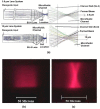Optofluidic Device Based Microflow Cytometers for Particle/Cell Detection: A Review
- PMID: 30407441
- PMCID: PMC6189758
- DOI: 10.3390/mi7040070
Optofluidic Device Based Microflow Cytometers for Particle/Cell Detection: A Review
Abstract
Optofluidic devices combining micro-optical and microfluidic components bring a host of new advantages to conventional microfluidic devices. Aspects, such as optical beam shaping, can be integrated on-chip and provide high-sensitivity and built-in optical alignment. Optofluidic microflow cytometers have been demonstrated in applications, such as point-of-care diagnostics, cellular immunophenotyping, rare cell analysis, genomics and analytical chemistry. Flow control, light guiding and collecting, data collection and data analysis are the four main techniques attributed to the performance of the optofluidic microflow cytometer. Each of the four areas is discussed in detail to show the basic principles and recent developments. 3D microfabrication techniques are discussed in their use to make these novel microfluidic devices, and the integration of the whole system takes advantage of the miniaturization of each sub-system. The combination of these different techniques is a spur to the development of microflow cytometers, and results show the performance of many types of microflow cytometers developed recently.
Keywords: microfabrication; microflow cytometer; microfluidics; optofluidic device.
Conflict of interest statement
The authors declare no conflict of interest.
Figures











Similar articles
-
Optofluidic Flow Cytometer with In-Plane Spherical Mirror for Signal Enhancement.Sensors (Basel). 2023 Nov 15;23(22):9191. doi: 10.3390/s23229191. Sensors (Basel). 2023. PMID: 38005576 Free PMC article.
-
The good, the bad, and the tiny: a review of microflow cytometry.Anal Bioanal Chem. 2008 Jul;391(5):1485-98. doi: 10.1007/s00216-007-1827-5. Epub 2008 Jan 29. Anal Bioanal Chem. 2008. PMID: 18228010 Free PMC article. Review.
-
A Microflow Cytometer Enabled by Monolithic Integration of a Microreflector with an Acoustic Resonator.ACS Sens. 2024 Mar 22;9(3):1428-1437. doi: 10.1021/acssensors.3c02530. Epub 2024 Feb 21. ACS Sens. 2024. PMID: 38382073
-
The intersection of flow cytometry with microfluidics and microfabrication.Lab Chip. 2014 Mar 21;14(6):1044-59. doi: 10.1039/c3lc51152a. Lab Chip. 2014. PMID: 24488050 Free PMC article. Review.
-
Handheld Microflow Cytometer Based on a Motorized Smart Pipette, a Microfluidic Cell Concentrator, and a Miniaturized Fluorescence Microscope.Sensors (Basel). 2019 Jun 19;19(12):2761. doi: 10.3390/s19122761. Sensors (Basel). 2019. PMID: 31248214 Free PMC article.
Cited by
-
On-chip flow cytometer using integrated photonics for the detection of human leukocytes.Sci Rep. 2024 May 20;14(1):10921. doi: 10.1038/s41598-024-60708-0. Sci Rep. 2024. PMID: 38769346 Free PMC article.
-
Optofluidic detection setup for multi-parametric analysis of microbiological samples in droplets.Biomicrofluidics. 2020 Apr 9;14(2):024109. doi: 10.1063/1.5139603. eCollection 2020 Mar. Biomicrofluidics. 2020. PMID: 32547676 Free PMC article.
-
A Transit Time-Resolved Microflow Cytometry-Based Agglutination Immunoassay for On-Site C-Reactive Protein Detection.Micromachines (Basel). 2021 Jan 22;12(2):109. doi: 10.3390/mi12020109. Micromachines (Basel). 2021. PMID: 33499089 Free PMC article.
-
Automated Microfluidic Droplet-Based Sample Chopper for Detection of Small Fluorescence Differences Using Lock-In Analysis.Anal Chem. 2017 Jun 6;89(11):6153-6159. doi: 10.1021/acs.analchem.7b00991. Epub 2017 May 11. Anal Chem. 2017. PMID: 28467848 Free PMC article.
-
Advances in Microflow Cytometry-Based Molecular Detection Methods for Improved Future MDS Cancer Diagnosis.Curr Issues Mol Biol. 2024 Jul 26;46(8):8053-8070. doi: 10.3390/cimb46080476. Curr Issues Mol Biol. 2024. PMID: 39194693 Free PMC article. Review.
References
-
- Horowitz V.R., Awschalow D.D., Pennathur S. Optofluidics: Field or technique? Lab Chip. 2008;8:1856–1863. - PubMed
Publication types
Grants and funding
LinkOut - more resources
Full Text Sources

